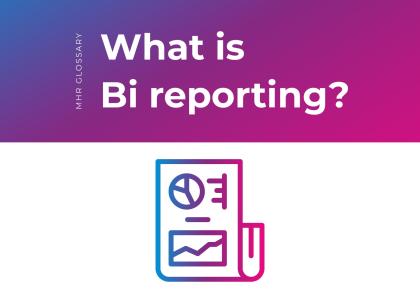Understanding BI reporting
BI data can include a range of things, such as:
- Inventory counts
- Revenue
- Sales data
- Customer information
- Dates
- Purchase orders
There are two stages to BI reporting. The first is collecting data in a secure and ethical way from a range of sources and presenting it in a way that means your data experts can analyse it. The second stage is analysing that data, drawing out information and actionable insights that the rest of the business can work with.
The goal of all this is to create insights that can support decision making. It’s also useful for removing data silos. BI reporting enables a single source of truth that uses consistent data sets, and usually coming from the same platform. This makes data analysis take much less time and ensures that decisions are more accurate. That gives everyone extra confidence in the results.
Examples of BI reporting
There are many examples of BI reporting, some of which you may already be using.
Self-service BI
Traditional methods of BI typically revolve around an analyst or other employees with a high degree of technical knowledge to interface with the system and provide insights. However, this means other people in the organisation who lack that skill won’t be able to analyse any data. This can lead to huge issues as everyone relies on those select few to handle everything. At the best of times, this causes bottlenecks. At worst, it can leave you floundering when these employees leave.
Self-service BI refers to a system that enables non-technical employees to analyse their own data to an extent. More advanced insights will still require the experts, but more day-to-day analysis can be done by the person who needs it.
Whether or not you have access to self-service BI depends heavily on the platform you’re using. Many BI platforms are focused on supporting your experts, not the average person.
Dashboards and data visualisation
A dashboard is a method of showing different types of data in a single place. As a rule of thumb, dashboards are fairly top level, and should be easy to digest. They’re ideal for presenting data to stakeholders that they need to understand at a glance. Often, you’ll see real-time dashboards that update as soon as new data comes in.
Interactive dashboards are typically quite customisable, so you can make sure they’re showing data that’s of relevance to you and your team.
It’s important to distinguish between reports and dashboards. Dashboards tend to be broader, covering lots of data, while reports are more focused on answering a specific question.
Static reports and alerting
Static reports are, as the name implies, static. You’ll usually generate one as and when they’re needed, then store them for archival purposes.
Traditionally, static reports come from tools like excel. There’s not much scope to drill down further, and they tend to stop being useful very quickly.
Real-time dashboards and data offer up more dynamic options.
Augmented analytics
Augmented analytics use AI to assist with the various stages of BI reporting. For example, machine learning tools can create algorithms and speed up data cleaning.
Augmented analytics is not the same as automation. Automation removes the need for a human entirely, while augmentation provides additional support.
Because of the ethical and legal concerns that come with automation (in many countries, people have the right to challenge a decision made solely by an AI, for example), augmentation is a much less risky proposition. It enhances what you already have, and ensures human judgement is still what makes the final call.
Embedded BI analytics
Embedded analytics are all about integration. It’s about putting analytical abilities directly into a non-analytical software. CRMs and ERPs commonly feature embedded analytics. This makes it a lot easier for everyone to get the data they need, improving data democratisation.
Best practices in BI reporting
What good BI reporting looks like will vastly depend on what you and your company need. However, there are some good habits that you can push that will work for any business.
While your analysts will be doing the bulk of BI reporting, ideally your decision makers should be able to look at reports, understand them, and make informed decisions without necessarily needing an analyst to explain it to them.
Wherever possible, you should look into data democratisation and avoid situations where bottlenecks will occur. This means everyone takes more ownership of their own data requirements, and your analysts can focus on more in-depth tasks that use their expertise properly.
Adaptability is also key. Don’t try and crowbar your reporting processes to fit your business. Likewise, don’t set things up and then neglect innovation. BI reporting is constantly evolving, and there may be new developments to bring in.
Finally, no matter how advanced the data analysis gets, preparing reports with the end user in mind is always valuable. Who will be reading the report? Is it understandable?
Implementing BI reporting in your business
Crucially, BI reporting relies heavily on the platform you use. You need to make sure you choose the right one for your needs, which means you need to figure out where you are now and where you want to be in the future.
Steps can be taken before this point to assess your data maturity and build out a plan that works for the entire company.
If you’d like some help with the next steps, get in touch with our team. We’ll help you leverage all your business data into a BI reporting powerhouse.


